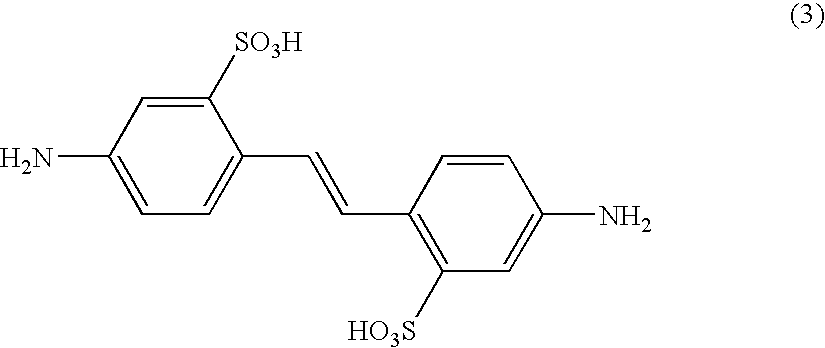Optical Brightening Compositions For High Quality Inkjet Printing
a brightening composition and inkjet printing technology, applied in the direction of luminescent/fluorescent substance addition, non-fibrous pulp addition, papermaking, etc., can solve the problems of low print sharpness, poor absorbance of water-based anionic dyes or pigments, and high cost of paper production
- Summary
- Abstract
- Description
- Claims
- Application Information
AI Technical Summary
Problems solved by technology
Method used
Image
Examples
example 1
[0062]Stage 1: 31.4 parts of aniline-2,5-disulphonic acid monosodium salt are added to 150 parts of water and dissolved with the aid of an approx. 30% sodium hydroxide solution at approx. 25° C. and a pH value of approx. 8-9. The obtained solution is added over a period of approx. 30 minutes to 18.8 parts of cyanuric chloride dispersed in 30 parts of water, 70 parts of ice and 0.1 part of an antifoaming agent. The temperature is kept below 5° C. using an ice / water bath and if necessary by adding ice into the reaction mixture. The pH is maintained at approx. 4-5 using an approx. 20% sodium carbonate solution. At the end of the addition, the pH is increased to approx. 6 using an approx. 20% sodium carbonate solution and stirring is continued at approx. 0-5° C. until completion of the reaction (3-4 hours).
[0063]Stage 2: 8.8 parts of sodium bicarbonate are added to the reaction mixture. An aqueous solution, obtained by dissolving under nitrogen 18.5 parts of 4,4′-diaminostilbene-2,2′-di...
example 2
[0065]An aqueous solution of a compound of formula (1) in which M=Na, X=K and 4.5≦n≦5.5 (0.125 mol / kg, approx. 18.0%) is obtained following the same procedure as in Example 1 with the sole difference that an approx. 30% potassium hydroxide solution is used instead of an approx. 30% sodium hydroxide solution in Stage 3.
example 3
[0066]An aqueous solution of a compound of formula (1) in which M=Na, X=K and 2.5≦n≦4.5 (0.125 mol / kg, approx. 18.3%) is obtained following the same procedure as in Example 1 with the sole differences that 10 parts of potassium bicarbonate are used instead of 8.8 parts of sodium bicarbonate in Stage 2 and an approx. 30% potassium hydroxide solution is used instead of an approx. 30% sodium hydroxide solution in Stages 2 and 3.
PUM
| Property | Measurement | Unit |
|---|---|---|
| Temperature | aaaaa | aaaaa |
| Temperature | aaaaa | aaaaa |
| Concentration | aaaaa | aaaaa |
Abstract
Description
Claims
Application Information
 Login to View More
Login to View More - R&D
- Intellectual Property
- Life Sciences
- Materials
- Tech Scout
- Unparalleled Data Quality
- Higher Quality Content
- 60% Fewer Hallucinations
Browse by: Latest US Patents, China's latest patents, Technical Efficacy Thesaurus, Application Domain, Technology Topic, Popular Technical Reports.
© 2025 PatSnap. All rights reserved.Legal|Privacy policy|Modern Slavery Act Transparency Statement|Sitemap|About US| Contact US: help@patsnap.com



